Structured light
Tailoring light fields with a digital micromirror device
The digital micromirror device (DMD) becomes popular in spatial light modulation, due to its ability of complex amplitude modulation and high switching rate. Distinguished from the liquid crystal phase-type SLM, DMD can be seen as a binary-amplitude SLM. Shaping complex fields is realized by encoding the phase information on the binary hologram. For this purpose, Lee method or super-pixel method are commonly adopted to calculate the binary holograms. Despite of these matured methods, the topics for novel algorithms to produce the holograms are still open. For instance, we introduce an error diffusion algorithm to enhance the accuracy for binary-amplitude hologram design, making it possible to achieve high fidelity wavefront shaping while retaining a high resolution. We propose a direct binary search (DBS) method to design high-resolution complex-amplitude holograms for holographic image projection.
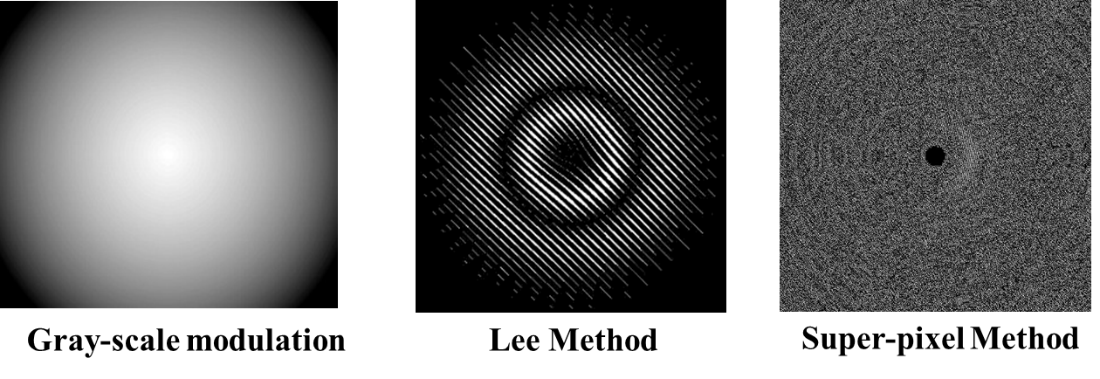
Two schemes of the optical system can be chosen for beam shaping: DMD in the image plane or in the Fourier plane. Big features in the Fourier plane correspond to small features in the image plane, and vice versa. In principle, a perfect, continuous SLM could perform equally in both scenarios. However, the modulation capability provided by a DMD is both discrete and binary, so that the degrees of freedom of the device are clearly limited. Thus, if a high-performance imaging system is at hand, a DMD in an image plane is perfectly suited for projecting big, complex shapes. The scenario is inverted if the DMD is placed in a Fourier plane. This scheme is ideally suited for small features, since those have board Fourier transforms, so that all degrees of freedom can go into the creation of a single small, high precision shape. Thus, it depends on the practical requirements.

Shaping structured light beams
Structured light refers to a class of custom light fields with special temporal and spatial evolution behaviors. Structured light could bring novel effects for light-matter interaction, and thus they are widely explored in the applied areas, such as optical manipulation, biomedical imaging, optical sensing and optical communications. Our group develops various DMD-based beam shaping techniques. The generation and characterization of structured light beams including non-diffracting light beams, accelerating light beams, vector light fields, OAM beams were demonstrated.
Optical bottle beams
We report on a novel class of controlled light capsules with nearly perfect darkness, directly employing intrinsic properties of modified Bessel-Gauss beams. These beams are able to naturally create three-dimensional bottle-shaped region during propagation as long as the parameters are properly chosen. Remarkably, the optical bottle can be controlled to demonstrate various geometries through tuning the beam parameters, thereby leading to an adjustable light capsule. We provide a detailed insight into the theoretical origin and characteristics of the light capsule derived from modified Bessel-Gauss beams. Moreover, a binary digital micromirror device (DMD) based scheme is first employed to shape the bottle beams by precise amplitude and phase manipulation [1].

OAM-carrying beams
We present an optimized Lee method to achieve dynamic shaping of orbital-angular-momentum (OAM) beams using a binary DMD. An error diffusion algorithm is introduced to enhance the accuracy for binary-amplitude hologram design, making it possible to achieve high fidelity wavefront shaping while retaining a high resolution. As a proof of concept, we apply this method to create different classes of OAM beams. The numerical simulations verify that a fidelity of F > 0.985 can be achieved for all the test OAM fields with fully independent phase and amplitude modulation. Moreover, we experimentally demonstrate the dynamic shaping of different OAM beams including pure modes and mixed modes with a switching rate of up to 17.8 kHz [2]. On this basis, accurate information encoding into the generated multiplexed OAM beams is accomplished, which provides access to high speed classical and quantum communications that employ spatial mode encoding.
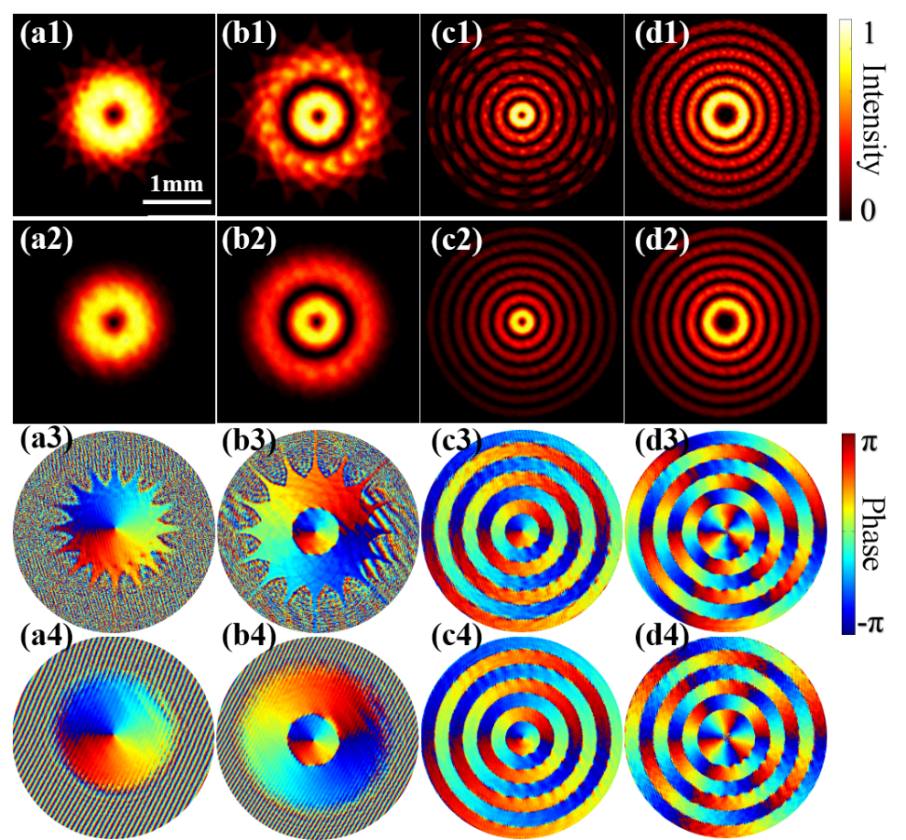
Vector vortex beams
We propose a novel technique to directly transform a linearly polarized Gaussian beam into vector-vortex beams with various spatial patterns. Full high-quality control of amplitude and phase is implemented via a DMD binary holography for generating Laguerre- Gaussian, Bessel-Gaussian, and helical Mathieu–Gaussian modes, while a radial polarization converter (S-waveplate) is employed to effectively convert the optical vortices into cylindrically polarized vortex beams [3]. Additionally, the generated vector-vortex beams maintain their polarization symmetry after arbitrary polarization manipulation.
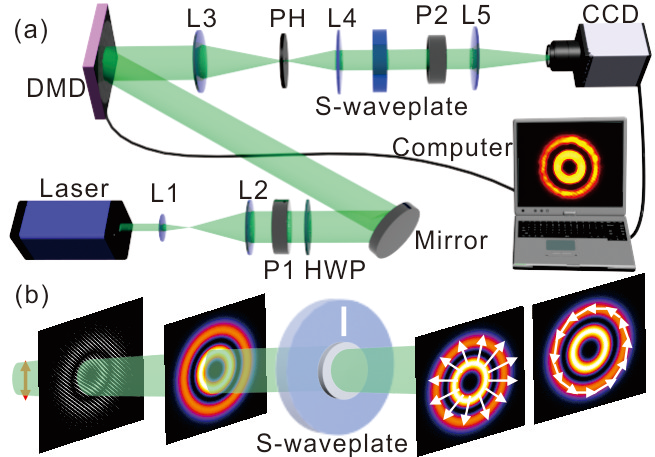

Non-diffraction LG beams
We construct a family of optical ring lattices that manifest quasi-nondiffracting property via superposition of high-radial-order Laguerre–Gaussian beams. Theoretical derivation of the optical ring lattice along with the validity condition is presented, and its evolution behaviors are investigated in comparison with the diffraction-free Bessel beams [4]. Moreover, multiple ultra-long bright channels or optical tubes with various transverse profiles can be formed with the ring optical lattices. As a proof of concept, flexible generation of the lattice beams was demonstrated by complex wavefront engineering using a binary digital micromirror device.

Synthesis and scanning of lattice light sheets
Lattice light sheet microscopy is uniquely positioned in biomedical imaging modalities due to its superior performance in temporal-spatial resolution and low photo-toxicity. However, the imaging system is commonly complicated because producing lattice light sheets involves mechanical scanning and precise alignment. We present an experimental scheme for motionless synthesis and scanning of lattice light sheets using a single digital micromirror device. By fully exploiting its ability of the complex amplitude modulation and fast switching, single-shot construction of a uniform lattice light sheet can be achieved by digital dithering. In particular, fast scanning of the lattice light sheet in the depth direction is also realized without any mechanical motion [5].

Spin-orbit interactions (SOIs) of light in tight focusing fields
Spin-orbit interactions (SOIs) of light in tight focusing systems have gained much attention due to the potential applications in optical trapping and microscopy. In these systems, SOI effects strongly affect the distributions and properties of focal fields, which are determined by the polarization and spatial degrees of freedom of incoming light. Remarkably, structured light fields exhibit SOI phenomena with complex behaviors. In a tightly focused circularly polarized field, SAM of incident light could be transformed into OAM in the focused field, which is termed as spin-to-orbit-conversion (SOC). Apart from SOC, the orbital-induced localized SAM, termed as local orbit-to-spin-conversion (OSC), can also occur under tight focusing. The control of SOI brings new applications in light-matter interactions, such as optical trapping and super-resolution microscopy.

We have revealed in theory that localized OSC occurs in strong focusing of spin-free linearly polarized vortex beams (LPVBs). By analysis of the polarization states that are associated with the SAM density, we attribute the occurrence of such a conversion to the helical-phase-induced change of local polarization states in the focused field. Particularly, the local SAM density can be further regulated by altering the sign and value of OAM in the incident LPVBs as well as their polarization orientations [6]. Such a local OSC has been verified experimentally by the interaction of light carrying OAM with a chiral dipolar scatterer.
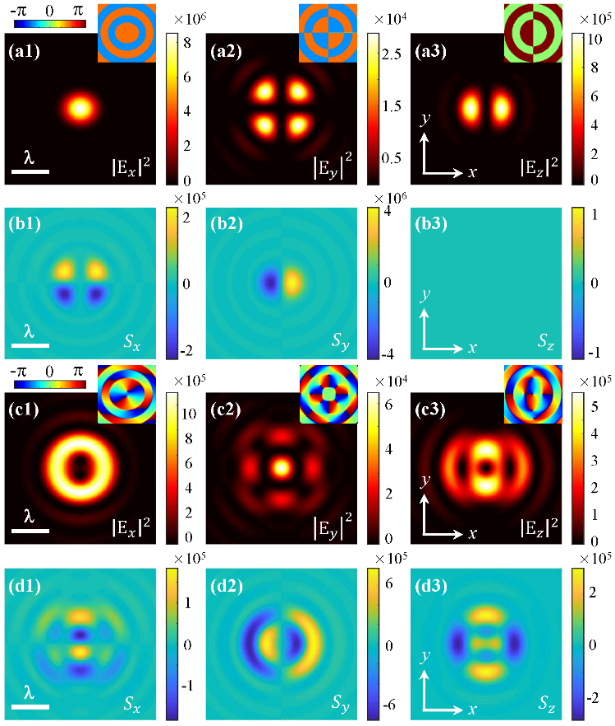
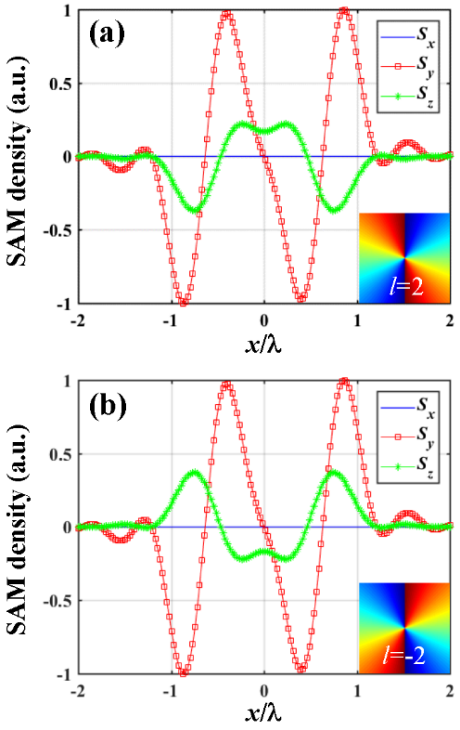
We theoretically study the SOIs in the tightly focused higher-order Poincaré sphere beams that simultaneously contain vortex phase front and higher polarization orders. The interplay between spin and orbital angular momentum in the focused field is revealed, and the amount of spin-orbit conversion is found to be determined by the angular momentum of the incident field and the focusing system. In particular, based on the superposition of two circular polarization vortex bases, a general description of the interplay between spin and orbit properties is provided, paving a way to arbitrarily control the SOIs in nonparaxial fields [7].


Reference:
[1] L. Gong, W. Liu, Q. Zhao, Y. Ren, X. Qiu, M. Zhong, and Y. Li, Controllable light capsules employing modified Bessel-Gauss beams, Scientific Reports 6, 1-12 (2016).
[2] X. Hu, Q. Zhao, P. Yu, X. Li, Z. Wang, Y. Li, and L. Gong, Dynamic shaping of orbital-angular-momentum beams for information encoding, Optics Express 26, 1796-1808 (2018).
[3] L. Gong, Y. Ren, W. Liu, M. Wang, M. Zhong, Z. Wang, and Y. Li, Generation of cylindrically polarized vector vortex beams with digital micromirror device, Journal of Applied Physics 116, 183105 (2014).
[4] Q. Zhao, L. Gong, X.-Y. Hu, P.-P. Yu, Z.-Q. Wang, and Y.-M. Li, Harnessing Laguerre-Gaussian beams to construct quasi-nondiffracting optical ring lattices, IEEE Photonics Journal 10, 1-7 (2018).
[5] Zhao Q, Tu S, Sun H, et al. Motionless synthesis and scanning of lattice light sheets with a single digital micromirror device[J]. Applied Physics Letters 120, 211106 (2018).
[6] P. P. Yu, Q. Zhao, X. Y. Hu, Y. M. Li, and L. Gong, Orbit-induced localized spin angular momentum in the tight focusing of linearly polarized vortex beams, Optics Letters 43, 5677-5680 (2018).
[7] P. P. Yu, Y. F. Liu, Z. Q. Wang, Y. M. Li, and L. Gong, Interplay between Spin and Orbital Angular Momenta in Tightly Focused Higher-Order Poincare Sphere Beams, Annalen Der Physik 532, 2000110 (2020).


